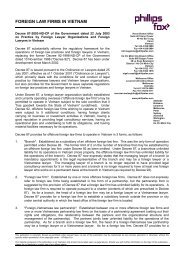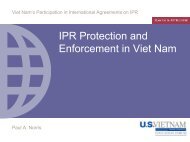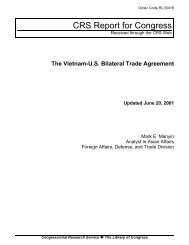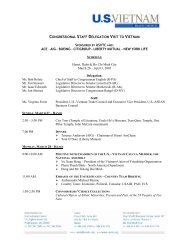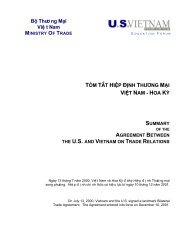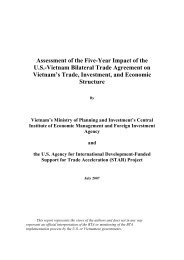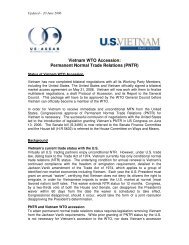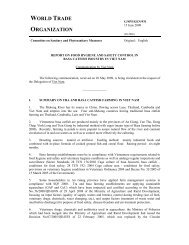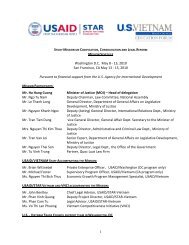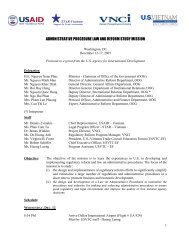Climate risks and adaptation in Asian coastal megacities: A synthesis
Climate risks and adaptation in Asian coastal megacities: A synthesis
Climate risks and adaptation in Asian coastal megacities: A synthesis
- No tags were found...
You also want an ePaper? Increase the reach of your titles
YUMPU automatically turns print PDFs into web optimized ePapers that Google loves.
15°N10°NThis map was produced by the Map Design Unit of The World Bank.The boundaries, colors, denom<strong>in</strong>ations <strong>and</strong> any other <strong>in</strong>formationshown on this map do not imply, on the part of The World BankGroup, any judgment on the legal status of any territory, or anyendorsement or acceptance of such boundaries.120°E 125°E5°N 120°E125°E5°N15°N10°Npalities. It is a low-ly<strong>in</strong>g area crisscrossed by thePasig River <strong>and</strong> its tributaries, which flows northwestwardfrom Laguna de Bay, the largest lake <strong>in</strong>the Philipp<strong>in</strong>es, to Manila Bay <strong>in</strong> the west. MetroManila lies on a swampy isthmus <strong>and</strong> is markedby three quite diverse hydrological characteristics.These <strong>in</strong>clude the Pasig Mariqu<strong>in</strong>a area, Kamanavaarea, <strong>and</strong> the west of Managhan area fac<strong>in</strong>g theLaguna de Bay (Figure 3.6). The Pasig Mariqu<strong>in</strong>aarea has several river systems <strong>and</strong> a catchment areaof 651 sq kms. It <strong>in</strong>cludes 10 cities/municipalitiesof Metro Manila. The Kamanava area along thelow-ly<strong>in</strong>g coast is flat, prone to typhoons, <strong>and</strong> haselevations rang<strong>in</strong>g from around sea level to 2–3meters above sea level. Before the 1960s, it ma<strong>in</strong>lyconsisted of lagoons, but has been filled up <strong>and</strong> currentlycomprises commercial districts, residentialareas, <strong>and</strong> fishponds. The West of Managhan areais 39 square kms <strong>and</strong> covers five cities. There area number of dra<strong>in</strong>age channels dra<strong>in</strong><strong>in</strong>g <strong>in</strong>to theLaguna Lake or Nap<strong>in</strong>dan River.Importance of Metro Manila to the regionaleconomyFigure 3.6 ■ Metro Manila <strong>and</strong> itsWatershedJANUARY 20100 5KILOMETERS14°40'MANILAManilaBayBacoor121°00'MeycauayanCaloocanPasig RiverM<strong>and</strong>aluyongParañaque121°00'San JoseDel MonteSan JuanQUEZONCITYPaterosTaguigMarik<strong>in</strong>aPasigR iverMarik<strong>in</strong>aLagunaBayRodriguezSan MateoSource: Philipp<strong>in</strong>es map IBRD 37476.AntipoloB<strong>in</strong>angonanBosobosoLagunaBayPililla121°20'PHILIPPINESPASIG – MARIKINA RIVERS121°20'MALAYSIATuguegaraoSan Fern<strong>and</strong>oBaguioSan Fern<strong>and</strong>oMANILA QuezonArea of MapSulu SeaPROJECT RIVERSWATERSHEDSELECTED CITIESREGION CAPITALNATIONAL CAPITALIloiloZamboangaIliganCotabatoCelebes SeaLegaspiTaclobanCebuREGION CAPITALSNATIONAL CAPITALREGION BOUNDARIESINTERNATIONALBOUNDARIESPhilipp<strong>in</strong>eSeaButuanCagay<strong>and</strong>e OroDavaoIBRD 37476Like Bangkok, Manila is also a capital city <strong>and</strong> amajor economic center. It is located on the easternshore of Manila Bay, on the western side of theNational Capital Region. It is a central hub of thethriv<strong>in</strong>g Metropolitan Manila area. With a populationof 11 million, it is ranked as one of the mostdensely populated cities <strong>in</strong> the world. The PasigRiver bisects the city <strong>in</strong> the middle before dra<strong>in</strong><strong>in</strong>g<strong>in</strong>to Manila Bay. Metro Manila, the broader urbanagglomeration, has the highest per capita GDP <strong>in</strong>the country. In 2007, its population was estimated tobe over 20 million people. In 2008, it was ranked asthe 40 th richest urban agglomerations <strong>in</strong> the world,with a GDP of $149 billion, <strong>in</strong>dicat<strong>in</strong>g the economicimportance of Metro Manila. Manila is also a majortourist dest<strong>in</strong>ation, with over 1 million tourists visit<strong>in</strong>gthe city each year.Unregulated expansion <strong>in</strong>to fragile areas<strong>and</strong> <strong>in</strong>formalityWith large <strong>in</strong>-migration <strong>and</strong> rapid populationgrowth, the city exp<strong>and</strong>ed to the suburbs, surround<strong>in</strong>gmunicipalities, <strong>and</strong> to areas risky forhabitation (e.g., swampy areas, near or above esterosor water canals, along the river or earthquakefault l<strong>in</strong>es, etc.). A large part of the developments<strong>in</strong> <strong>in</strong>formal settlements are unregulated. Manystructures are built on dangerous <strong>and</strong> risky areas,such as near the seashore or flood zone, or onground prone to l<strong>and</strong>slides. Socioeconomic factorslike l<strong>and</strong> use practices, <strong>in</strong>frastructure development,build<strong>in</strong>g st<strong>and</strong>ards/codes <strong>and</strong> practices, <strong>and</strong> urb<strong>and</strong>evelopment policies <strong>and</strong> programs have greatlyshaped the settlement <strong>and</strong> build<strong>in</strong>g patterns of thecity. These forces generate an environment thatposes high <strong>risks</strong> to residents <strong>and</strong> <strong>in</strong>frastructurealike, especially <strong>in</strong> the low-ly<strong>in</strong>g flood-prone areas.As <strong>in</strong> other cities <strong>in</strong> develop<strong>in</strong>g countries, there aresignificant wealth disparities <strong>in</strong> Manila that arereflective of the country as a whole, with 97 percentof GDP controlled by 15 percent of the population(WWF 2009). With<strong>in</strong> Metro Manila, 10.4 percent ofthe population <strong>in</strong> lives below the poverty l<strong>in</strong>e, accord<strong>in</strong>gto 2006 official statistics. 32 Approximately61 percent of the population <strong>in</strong> Metro Manila doesnot have access to basic services, accord<strong>in</strong>g to the2008 Philipp<strong>in</strong>e Asset report report card (cited<strong>in</strong> Manila study). There is an estimated hous<strong>in</strong>gbacklog of almost 4 million.32http://www.nscb.gov.ph/poverty/2006_05mar08/table_2.asp32 | <strong>Climate</strong> Risks <strong>and</strong> Adaptation <strong>in</strong> <strong>Asian</strong> Coastal Megacities: A Synthesis Report



